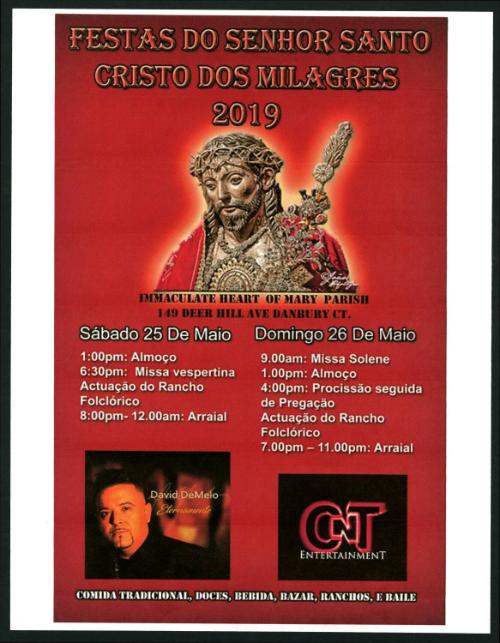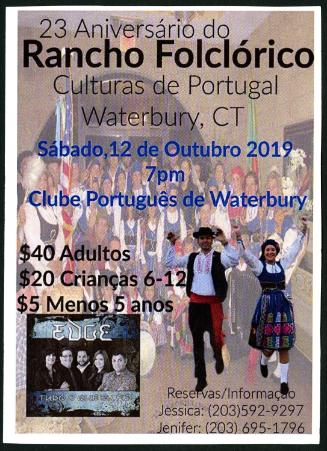Flyer: Festas do Senhor Santo Cristo dos Milagres
Date2019
MediumPaper
ClassificationsInformation Artifacts
Credit LineConnecticut Cultural Heritage Arts Program collections
CopyrightIn Copyright
Object number2015.196.61.4
DescriptionFlyer for Festas do Senhor Santo Cristo dos Milagres, 2019.
NotesSubject Note: Connecticut residents of Portuguese descent number nearly 50,000; there is a Portuguese Consulate in Waterbury, signaling the importance of this ethnic group's presence throughout the state. Waterbury, Bridgeport, Hartford, Danbury and Stonington CT have sizeable Portuguese communities with different roots and cultural characters. Portuguese immigrants have come from mainland Portugal as well as the Azores and Madeira islands. Settling mainly in urban areas of Connecticut, they established churches, shops, restaurants and bakeries, and social clubs. Many Hartford Portuguese community members work in health care and hospitals. Those settling near the south coast of Connecticut work in maritime industries. Cultural heritage is maintained strongly in Portuguese communities, seen in many festivals – often religious celebrations with processions – continuing throughout the state. Stonington holds a summer Blessing of the Fleet and Holy Ghost Festival in August, Waterbury celebrates Festa de Sao Joao in June, Naugatuck has the San Paio Festival over Labor Day, Danbury holds the Festa do Senhor Santo Cristo dos Milagres and other events, the Holy Ghost Society in East Hartford hosts a festival on its grounds, and Hartford organizes the Festa do Divino Espiritu Santo, the Festa do Sao Joao and the Day of Portugal, and St Martin’s Day in November (commemorating the crop of chestnuts), among other events. In addition to churches, social clubs in the cities are community centers of language, sports, newspapers, cultural activities, foodways and festivals. For instance, the Portuguese Club of Hartford was founded in 1927. In 2017 the Club suffered a devastating fire and is in the process of rebuilding, but the membership remains strong with a young population.In Danbury, The Sons of Portugal Club formed in 1924, on Liberty St. The community grew with new immigrants, and the Portuguese Club was also built on Liberty St. Other businesses followed to the downtown area, which became known as Portugal Square or Little Portugal. In the late 1990s, the community had grown to the point where the two clubs decided to merge and form the Portuguese Cultural Center, which was built on Sand Pit Rd. https://www.portugueseculturalcenter.org/
There are music and dance groups in Danbury: The Sons of Portugal Band was founded in 1940 by the members of the Sons of Portugal Club. Currently, the Band calls the Portuguese Cultural Center its home and continues to provide traditional band music to events in the Danbury area. Visit http://www.sopband.com for more information. “The Sons of Portugal Folklore Dance Group was founded on November 10, 1977 and is now situated within the Portuguese Cultural Center in Danbury, Connecticut. The group consists of musicians, dancers, singers with original costumes representing Portugal. The organization is formed by two types of Officers: Administrative and Artistic. This Folklore Group has a purpose not only for socialization among it’s members, but as well as to educate, stimulate, develop, encourage, cultivate, sponsor and promote public interest, awareness, appreciation and understanding of the traditional culture and language of Portugal.” From the group's previous website.
https://www.youtube.com/watch?v=dz2LhD3ual4
Rancho Folclorico Portugal Canta e Danca is a dance group formed in 1997 and based at the Portuguese Cultural Center at the Immaculate Heart of Mary Church on Deer Hill Ave. in Danbury. Members of this group wear costumes that are all the same (as different from other dance groups where the costumes vary among the dancers), and may be from the Minho region of Portugal. One special feature is the lace apron, it may be that this area specializes in lace, embroidery, and hand work (bordados) – see their facebook page for older procession photos suggesting this.
https://www.facebook.com/Portugalcantaedanca/
http://radiofamilia.com/canta.htm
https://www.escolamanuelcipriano.com/atividades-culturais-e-sociais/rancho-folclore/
https://www.youtube.com/watch?v=FLsxVTg5-L0
https://www.youtube.com/watch?v=Ez21jd8A9Qk
https://www.youtube.com/watch?v=38BWys1D9Ho
https://www.youtube.com/watch?v=naNAbZAguak
Additional audio, video, and/or photographic materials exist in the archive relating to this community and these events.
Cataloging Note: This project was made possible in part by the Institute of Museum and Library Services MA-245929-OMS-20.
Status
Not on viewSaint John the Baptist Parish of the Polish National Catholic Church
1993











